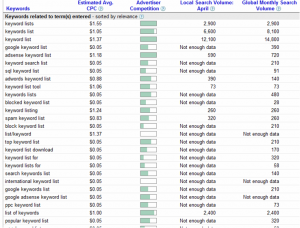Marketing Guides
Campaigns & Execution
Improve Your SEO and SEM with a Quality Keyword List
 If you’re revamping your website or launching a SEM campaign, the quality of your keyword list will play a significant role in your overall success.
If you’re revamping your website or launching a SEM campaign, the quality of your keyword list will play a significant role in your overall success.
It’s only logical, right?
When you optimize and advertise using popular keywords and phrases that are a good fit for your site, you increase your chances of obtaining traffic and converting it to leads and customers.
Let’s take a look at the steps involved in creating your list.
Step 1: Keyword Brainstorming
There are a number of free tools that can help you evaluate keywords, but a great way to get started is to think about your typical website visitors, their needs, and how your site fills those needs.
Start high-level and identify the user groups that visit your website. Include different types of prospects, current customers, media, potential employees, and other groups as needed.
Now for each user group, think about the terms they may use when looking for information on the web. Think in terms of the actual phrases people type into search engines. Consider both broad searches and exact searches:
- Broad searches: A user enters a very broad subject like “hotels.” These keywords generate high volume, but there’s a lot of competition so it’s difficult to rank highly for organic search (and expensive for paid search). You should focus on more specific searches.
- Highly targeted searches: “San Diego beachfront hotels” is a more specific phrase that will yield fewer results than the broad term “hotels,” but it may produce more qualified leads. It’s important to include specific keywords and phrases like this in your list.
Remember, people don’t always search using the exact terms that describe your product, site or industry. Put yourself in your prospects’ shoes and list the first words that come to mind when you think about looking for your product.
Continue this exercise and build lists for other user groups you want to find your website.
Step 2: Use Keyword Tools
When you’ve finished brainstorming, it’s time to refine and polish your keyword list by using some keyword tools. Since Google currently dominates search, the Google keyword tool might very well deliver all the information you need.
Google analytics: https://adwords.google.com/select/KeywordToolExternal
Type words or phrases into the tool and Google will deliver the estimated monthly search volumes along with related keyword suggestions. Use these results to expand your list and prioritize your search terms based on volume.
If you’re looking for lists that rank keywords, Wordtracker has a paid list.
Step 3: Check Your Competition
Finally, check your competitors to see what keywords they’re using. Start with those competitors with the highest ranked sites. Use the Google toolbar (you can download it at http://toolbar.google.com) to see links to your competitors’ sites and to see how well Google recognizes the pages of their websites.
A higher PageRank means that Google deems the site to be “more important” than sites with a lower PageRank. The number and quality of inbound links to the site play an enormous role in the rating; so does the site’s content, and the way it’s organized, as well as how it’s viewed by spiders. Newer sites will take a while to increase their ranking.
Next, right-click your mouse anywhere on the home page of a competitor’s site. Check “View Source” and you’ll be able to view the source code for the page.
Copy the source code and look for two sections near the top: “meta description” and “keywords.” These are the keywords your competitor is using. Go through and select any that seem relevant and important to your users, and add them to your list.
You can enter them into the Google keyword tool to estimate search volume.
Put It All Together
Review your list a final time and rank the keywords in order of importance. If you’re using the list to optimize your current website or a new one, select a smaller core group of keywords to use in your site architecture, headers, content, links and body copy.
If you’re launching a pay-per-click campaign, keep more keywords on your list. We’ll discuss how to organize them in your campaigns in a separate article.
For great SEO tips, check out Aaron Wall and SEO Book.com.
SEO AND SEM TEMPLATES / MARKETING PLANS / PROJECT MANAGEMENT
EVERYTHING YOU NEED FOR YOUR MARKETING PROJECT